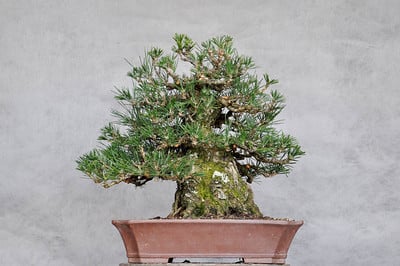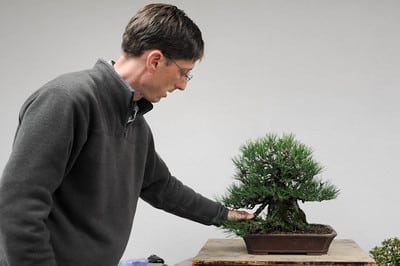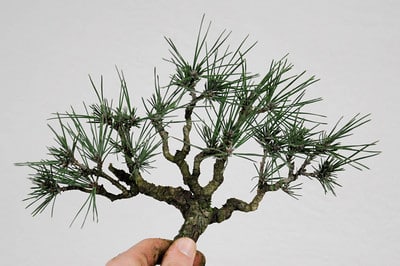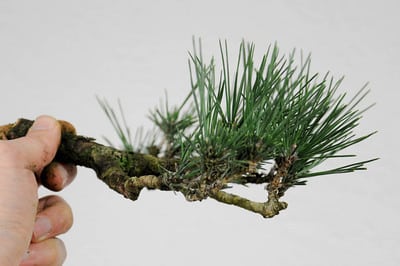On my first and only visit to Kihachiro Kamiya’s nursery in 1999, I found Daisaku Nomoto working on a young black pine. It was close to 30 years old, and the tree was beautiful to me; it had a large base and fast taper and was more full than the pines I was used to seeing in California. Nomoto surveyed the tree and wondered aloud, “Hmm, what should I cut. This one?” he said as he removed a small branch near the top of the tree. Next he pointed to the largest branch on the tree and repeated his question: “this one?” He moved concave cutters into place and looked at me, nodding up and down, then side to side, in an attempt to elicit a yes or no from me. Before I could respond he gasped, “Ah!” and the branch fell away. He quickly removed the first branch on the other side of the tree, pulled a few needles, and returned the tree to the bench to repeat the process with another pine.
It was a little disconcerting. I trusted his judgement, but was surprised he was removing such significant branches without checking with his teacher or putting much thought into the decision.
I later learned from Boon that this is a common approach to developing Japanese black pines. As branches grow thick over time, they are occasionally replaced with younger and thinner branches that provide better balance with the trunk.
Eleven years later I sat before one of my own black pines. The tree was quite full and the trunk had fast taper. And the lowest branches were getting big. Here is the tree as exhibited in 2009.

Japanese black pine, height: 15″ – January 2009
Later that year, I removed the first branch on the right side. The photo below is from June, just after decandling, cutback, and summer needle-plucking.

June 2009 – first branch on the right removed
The first “branch” on the right was actually two branches – a smaller branch on the left and a larger branch on the right.

Cuts from previous first branch on the right side
I let the tree grow for another year and was struck now by the first branch on the left. By removing it I could give younger, thinner branches a chance to develop and fill in, but I wouldn’t be able to show the tree for several years.

November 2010
Not being able to show the tree wasn’t much of a concern for me. I’d already planned to significantly reduce the tree’s silhouette – removing the first branch on the left would help with this.

Considering the cut
OK, so it wasn’t a very tough decision in this case. It was, however, the first time I’d replaced the main branches of a pine with much younger branches.
Taking a closer look at the branch I removed made me feel better about the decision. It was surprisingly thick for supporting so little foliage, and it was far from the most beautiful branch on the tree.

Removed branch – top view
The branch looked far better when viewed from the side.

Removed branch – side view
After removing the branch I completed some minor cutback and thinned unnecessary needles.

January, 2011
The tree is a bit rangy now, but I think it will look far better wired. I’ll see if I can get to that as soon as I catch up on my repotting. I have 4-6 weeks to repot most of my trees, and this coming weekend is Bay Island Bonsai’s 12th Annual Exhibit. The wiring will have to wait.
Subscribe to Bonsai Tonight
New Posts Delivered Every Tuesday and Friday
John Romano says
Necessary work! But we all hesitate a little more then those with the bonsai instincts chiseled from years of watching / doing. Good post.
john
Andrew Ward says
Fantastic photo story. So often people are reluctant to take action on the ‘big decisions of little trees’. We are not aiming fir ‘instant bonsai’ but need to keep in our mind the long tern development if our trees. Thanks for sharing this journey … I think there is a saying about ‘no glory without guts!’. The decisions you have made and implemented will take your tree to another level of refinement and ‘glory’.
Marc says
The saying I invoke is “No guts, No glory”! I have found it critical for Bonsai and this is a great lesson to share with this JBP. His future is bright thanks to the courage Jonas had.
Nice tree, well illustrated point!
Ram says
Dare I say it? ok “no cuts, no glory”
Thanks for the time you put into sharing your progess, it is appreciated.
Keith says
hey Jonas, I noticed on your fantastic pine that several branches stem from one spot. Is that a common practice?I always thought it was necessary to have only two branches per whorl to prevent reverse taper and swelling. Thank you for sharing all these wonderful articles, your blog has greatly expanded my bonsai knowledge.
Keith
xwires says
Hi Keith, thanks for the note! Growing multiple branches from the same location on the trunk is certainly not a basic development process. I imagine that whoever developed this tree began with single branches and then encouraged the additional shoots as they appeared for the purpose of replacing the original branches when the time came. Keeping many branches in the same place when the tree is young can, as you mention, quickly lead to unwanted swelling.